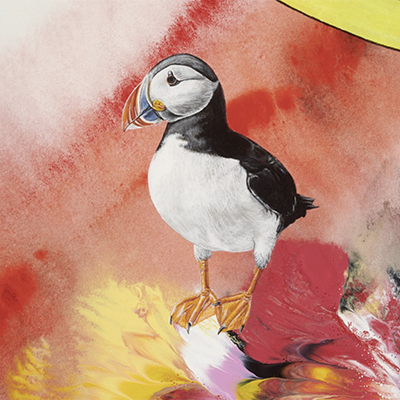“ Although many issues are referenced, my works remain non-linear, seeking to raise questions rather than to give answers.”

American, Born in Binghamton, New York / Lives in San Francisco, California
Kara Maria is a visual artist working in painting and mixed media. Her recent work reflects on Earth’s biodiversity crisis and the place of animals in our increasingly unstable environment. She borrows from the broad vocabulary of contemporary painting, blending geometric shapes, vivid hues, and abstract marks, with representational elements.
Maria received her BA and MFA from the University of California, Berkeley. She has exhibited work in solo and group shows throughout the United States at venues including the de Saisset Museum, Santa Clara University, CA; the Sonoma Valley Museum of Art, Sonoma, CA; the Nevada Museum of Art, Reno, NV; the Contemporary Arts Museum, Houston, TX; and the Katonah Museum of Art in New York; among many others.
Her work has garnered critical attention in the Los Angeles Times, the San Francisco Chronicle, and Art in America. Maria has been awarded artist residencies at the Montalvo Arts Center, Recology Artist in Residence Program, Djerassi Resident Artists Program, and at the de Young’s Artist Studio.
She has been a recipient of many awards and honors, including a grant from Artadia, New York, NY; an Eisner Prize in Art from UC Berkeley; and the Masterminds Grant from SF Weekly.
Maria’s work is included in the permanent collections of the Berkeley Art Museum and Pacific Film Archive(BAMPFA); the Crocker Art Museum in Sacramento; the Fine Arts Museums of San Francisco (Achenbach Foundation); the San Jose Museum of Art; and the Cantor Center at Stanford University; among others. Artwork is available through Anglim/Trimble, San Francisco, CA; Gail Severn Gallery, Ketchum, ID; and Mark Moore Fine Art, Los Angeles, CA.
Artist Statement about Museo show and Heritage:
My work is a visual dialogue between abstraction and representation in paintings, drawings, and prints. I borrow from the broad vocabulary of contemporary painting, blending geometric shapes, vivid hues, brush-marks, and stains with a host of social and environmental concerns seen through flashes of representational elements. I have included images such as cellphone towers; surveillance cameras; fragments of women’s bodies; the wreckage left behind after disasters; military aircraft; and birds in flight. Other reference materials for my work include comic books, Japanese woodblock prints, and camouflage patterns. I am aesthetically influenced by the popular culture of the 1970s – especially the toys I grew up playing with like Lite Brite, Colorforms, and Spirograph. This exhibition includes works made between 1999 and 2019. My recent work reflects on Earth’s biodiversity crisis and the place of endangered animals in our increasingly unstable environment.
I have been asked to consider the influence of my Italian American heritage on my artwork. My mother’s grandparents immigrated to the United States from Italy (from Arzignano in the Veneto region; and from Ancona in the Marche region) in the early 20th century. I never met my great grandparents, but I did grow up with lots of interaction with my grandparents. My early ideas about what it meant to be Italian American came from them, and from my mother—and involved both large quantities of food, and attending Catholic Mass on Sundays. My grandparents both spoke Italian but did not pass the language down to their children.
I visited Italy for the first time in 1990, when I was 21 years old and travelling in Europe after participating in a study abroad program in Paris. I went to Rome to visit some of my grandfather’s cousins. At the time, I was just developing an interest in visual art. The magnificent museums I visited during my time in Europe inspired me to take my first painting class upon my return to the US. Since then, I have visited Italy multiple times—often to view the Venice Biennale.
I hope my artwork communicates a sense of humor and playfulness as well as an engagement with the world we live in today. Although many issues are referenced, the work itself remains non-linear, seeking to raise questions rather than to give answers.

